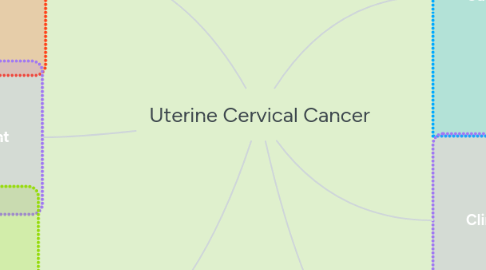Uterine Cervical Cancer
by Rebecca Bustos


1. Diagnosis
1.1. Histology Evaluation
1.1.1. Most type is defined as squamous cell carcinoma
1.2. History and Physical
1.2.1. See risk factors
1.2.2. Cervix may have visible lesions upon examination which can then be biopsied
1.2.3. Pelvic exam
1.2.4. Lymph node exam
2. Treatment
2.1. Hysterectomy with pelvic lymphadenectomy
2.2. Primary tradition therapy if surgical options are not possible
2.3. Chemotherapy like cisplatin and paclitaxel
3. Infection with Human papilloma virus (HPV)
3.1. Most common sexually transmitted infection in the United States
3.2. There are 15 high-risk strains that can lead to cervical cancer and cancer in the anus, penis, vagina, vulva and oropharynx
3.2.1. Some HPV virus types only cause warts
3.3. Persistent HPV infection can progress to cancer and it is slow growing
3.3.1. Usually the infection clears out on its own
3.4. HPV vaccine can be given as early at the age of 9 to help protect against certain strains that can lead to cancer
3.5. Screening
3.5.1. Pap smears are done to test for abnormalities in tissue and also can screen for HPV infection
3.6. Once infected with HPV, the virus will live/attack squamous epithelial cells such as those found on the cervix
4. Causative Factors
4.1. estrogen-progestron contraceptives
4.2. Human papilloma virus (different types)
4.2.1. Most cervical cancer cases are related to the HPV infection
4.3. tobacco smoking
4.3.1. Increases risk in particular with squamous cell carcinoma type
